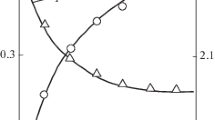Abstract
It is shown that theoretical models elaborated for polymer microcomposites are not capable to describe variation of the melt viscosity of polypropylene/globular carbon nanocomposites at change in the nanofiller contents. Then a fractal model of viscosity is proposed, which takes into account the sizes of nanofiller aggregates and their surface structure. This model shows a good agreement with experimental data. It demonstrates a fundamental difference in the behavior of melt viscosity for polymer micro- and nanocomposites.



Similar content being viewed by others
REFERENCES
Mikitaev, A.K., Kozlov, G.V., and Zaikov, G.E., Polymer Nanocomposites: Variety of Structural Forms and Applications, New York: Nova Science, 2008.
Mills, N.J., The Rheology of Filled Polymers, J. Appl. Polymer Sci., 1971, vol. 15, no. 11, pp. 2791–2805.
Balankin, A.S., Sinergetika deformiruemogo tela(Synergetics of Deformable Body), Moscow: MO SSSR, 1991.
Kozlov, G.V. and Sanditov, D.S., Angarmonicheskie effekty i fiziko-mekhanicheskie svoistva polimerov (Anharmonic Effects and Physical-Mechanical Properties of Polymers), Novosibirsk: Nauka, 1994.
Kozlov, G.V., Yanovsky, Yu.G., and Zaikov, G.E.,Particulate-Filled Polymer Nanocomposites. Structure,Properties, Perspectives, New York: Nova Science, 2014.
Mikitaev, A.K. and Kozlov, G.V., How to Define a Nanocomposite by the Example of Polymer/Organoclay Nanostructured Composites,Phys. Solid State, 2017, vol. 59, no. 7, pp. 1446–1449.
Kozlov, G.V., Dolbin, I.V., and Zaikov, G.E., The Fractal Physical Chemistry of Polymer Solutions and Melts, Toronto, New Jersey: Apple Academic, 2014.
Mikitaev, A.K. and Kozlov, G.V., The Role of Interface Surfaces in the Formation of the Properties of Polymer Nanocomposites, J. Surf. Investig. X-Ray, Synchrotron Neutron Techniq., 2016, vol. 10, no. 1, pp. 250–253.
Mikitaev, A.K. and Kozlov, G.V., Structural Model for the Reinforcement of Polymethyl Methacrylate/Carbon Nanotube Nanocomposites at an Ultralow Nanofiller Content, Techn. Phys., 2016, vol. 61, no. 10, pp. 1541–1545.
Kozlov, G.V. and Zaikov, G.E., Structure of the Polymer Amorphous State, Utrecht, Boston: Brill Academic, 2004.
Gold’stein, R.V. and Mosolov, A.B., Flows of Fractally-Broken Ice,Dokl. AN, 1992, vol. 324, no. 3, pp. 576–581.
Kozlov, G.V. and Dolbin, I.V., Percolation Models for Describing the Degree of Amplification of the Elastic Modulus of High-Filled Polyurethane/Graphene Nanocomposites, Prikl. Fiz., 2017, vol. 3, pp. 96–100.
Author information
Authors and Affiliations
Corresponding author
Rights and permissions
About this article
Cite this article
Kozlov, G.V., Dolbin, I.V. Fractal Treatment of Melt Viscosity of Polypropylene/Globular Carbon Nanocomposites. J. Engin. Thermophys. 30, 163–169 (2021). https://doi.org/10.1134/S1810232821010124
Received:
Published:
Issue Date:
DOI: https://doi.org/10.1134/S1810232821010124




